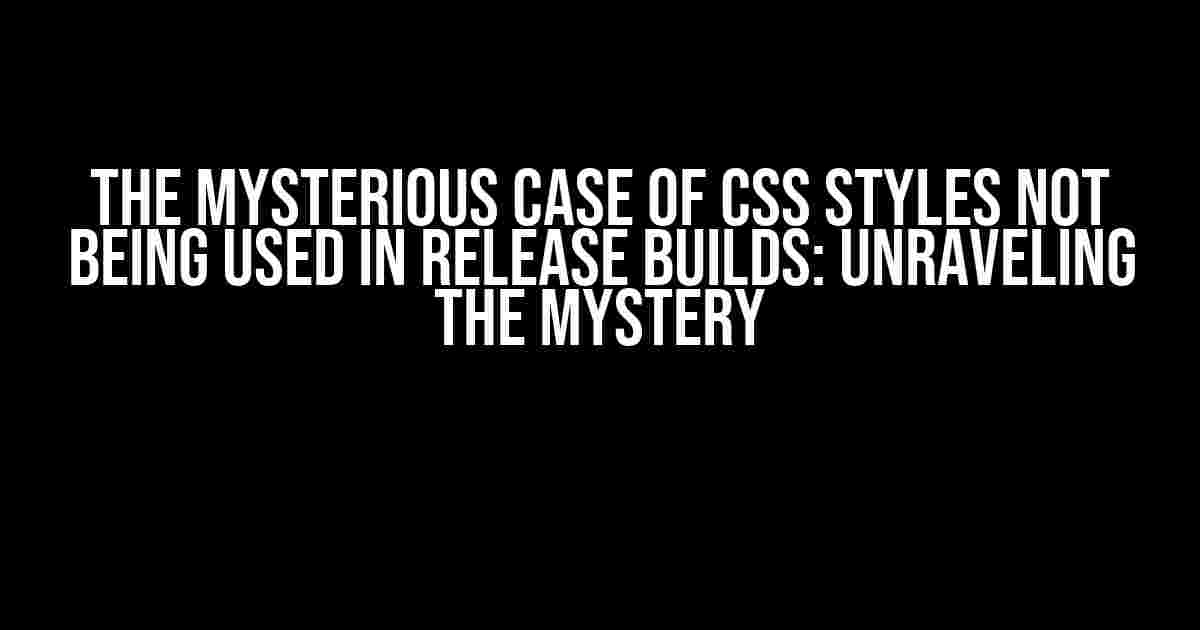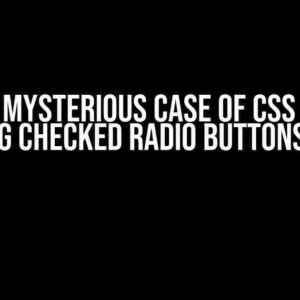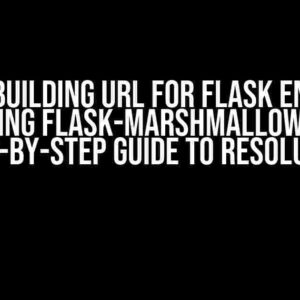Have you ever wondered why your beautiful CSS styles that looked perfect in development mode suddenly vanished in the release build? You’re not alone! Many developers have encountered this frustrating issue, and today, we’re going to uncover the secrets behind this phenomenon.
What’s Going On?
When you build your project in release mode, the compiler and minifier tools strip away any unnecessary code to optimize the app for production. This process, although intended to improve performance, can sometimes misinterpret your CSS code and eliminate styles that you intended to keep.
In this article, we’ll explore the reasons behind this issue, and more importantly, provide you with actionable solutions to ensure your CSS styles are preserved in release builds.
Cause 1: Unused CSS Selectors
One common reason for CSS styles not being used in release builds is the presence of unused CSS selectors. When the compiler optimizes your code, it removes any CSS rules that don’t have a corresponding HTML element in the codebase. This is done to reduce the overall file size and improve performance.
/* Unused CSS selector */
.my-unused-class {
background-color: red;
}In the above example, if there’s no HTML element with the class “my-unused-class”, the compiler might remove this CSS rule, resulting in the style not being applied in the release build.
Solution: Remove Unused CSS Selectors
The simplest solution is to remove any unused CSS selectors from your code. You can use tools like PurifyCSS or Uncss to identify and remove unused CSS rules.
/* Remove unused CSS selectors using PurifyCSS */
purify(['index.html', 'about.html'], {
css: ['styles.css']
});Cause 2: CSS rules with no declarations
Another reason for CSS styles not being used in release builds is the presence of CSS rules with no declarations. These rules are essentially empty and serve no purpose, so the compiler removes them.
/* CSS rule with no declarations */
.my-empty-rule {}In this example, the CSS rule “.my-empty-rule” has no declarations, making it unnecessary and prone to removal by the compiler.
Solution: Remove CSS rules with no declarations
The solution is straightforward: remove any CSS rules with no declarations from your code. You can use linters like CSSLint to identify and fix these issues.
/* Remove CSS rules with no declarations using CSSLint */
csslint --warnings="empty-rules" styles.cssCause 3: Duplicate CSS Rules
Duplicate CSS rules can also cause issues in release builds. When the compiler encounters multiple rules with the same selector and properties, it might remove the duplicates, resulting in the loss of intended styles.
/* Duplicate CSS rules */
.my-duplicate-rule {
background-color: red;
}
.my-duplicate-rule {
background-color: blue;
}In this example, the duplicate CSS rules for “.my-duplicate-rule” can cause issues in the release build.
Solution: Merge Duplicate CSS Rules
The solution is to merge duplicate CSS rules into a single rule. You can use tools like CSS-Merge to automate this process.
/* Merge duplicate CSS rules using CSS-Merge */
css-merge styles.css --output merged-styles.cssCause 4: Misconfigured Build Tools
Sometimes, misconfigured build tools can cause CSS styles not to be used in release builds. For example, if your bundler or minifier is not configured correctly, it might remove important CSS rules.
/* Misconfigured Webpack build tool */
module.exports = {
// ...
module: {
rules: [
{
test: /\.css$/,
use: [
{
loader: 'css-loader',
options: {
// Remove important CSS rules
discardComments: {
removeAll: true
}
}
}
]
}
]
}
};In this example, the Webpack configuration is set to remove all comments, including important CSS rules.
Solution: Configure Build Tools Correctly
The solution is to configure your build tools correctly. Make sure to review your configuration files and adjust the settings to preserve important CSS rules.
/* Correctly configured Webpack build tool */
module.exports = {
// ...
module: {
rules: [
{
test: /\.css$/,
use: [
{
loader: 'css-loader',
options: {
// Preserve important CSS rules
discardComments: {
removeAll: false
}
}
}
]
}
]
}
};Best Practices to Avoid CSS Styles Not Being Used in Release Builds
To avoid CSS styles not being used in release builds, follow these best practices:
- Write clean and concise CSS code: Avoid unused CSS selectors, duplicate CSS rules, and CSS rules with no declarations.
- Use a linter or code analyzer: Tools like CSSLint, CSS-Merge, and PurifyCSS can help identify and fix issues in your CSS code.
- Configure build tools correctly: Review your build tool configurations to ensure they preserve important CSS rules.
- Use a CSS preprocessor: CSS preprocessors like Sass or Less can help you write more efficient and modular CSS code.
- : Write unit tests or use visualization tools to ensure your CSS styles are being applied correctly.
Conclusion
The mysterious case of CSS styles not being used in release builds can be solved by understanding the causes and applying the solutions outlined in this article. By following best practices, configuring build tools correctly, and using the right tools, you can ensure your beautiful CSS styles are preserved in release builds.
Remember, a well-optimized CSS codebase is a key to a fast and efficient web application. Don’t let your hard work on CSS styling go to waste!
| Causes | Solutions |
|---|---|
| Unused CSS Selectors | Remove unused CSS selectors using PurifyCSS or Uncss |
| CSS rules with no declarations | Remove CSS rules with no declarations using CSSLint |
| Duplicate CSS Rules | Merge duplicate CSS rules using CSS-Merge |
| Misconfigured Build Tools | Configure build tools correctly to preserve important CSS rules |
By understanding and addressing these common causes of CSS styles not being used in release builds, you can ensure your web application looks and performs its best.
Frequently Asked Question
Get clarity on CSS styles not used or available in release builds with our expert answers!
Why do CSS styles not appear in release builds?
In release builds, CSS styles might not appear due to the bundling and minification process. This process removes unused CSS selectors, which can lead to some styles not being applied. To avoid this, ensure that all CSS selectors are used in your code or use a tool to remove unused CSS.
How do I identify unused CSS styles in my code?
There are several tools available to help you identify unused CSS styles, such as UnCSS, PurifyCSS, and Chrome DevTools. These tools analyze your code and provide a report on unused CSS selectors, making it easier to optimize your styles.
What is the difference between development and release builds in terms of CSS styles?
Development builds are typically used during the development process and include all CSS styles, whereas release builds are optimized for production and remove unused CSS styles to reduce file size and improve performance. This optimization process can sometimes lead to missing CSS styles in release builds.
Can I stop the removal of unused CSS styles in release builds?
Yes, you can prevent the removal of unused CSS styles by configuring your bundling and minification tools. For example, you can use the `–no-remove-comments` flag with the UglifyJS plugin to preserve comments and unused CSS styles. However, keep in mind that this may increase the file size and affect performance.
How can I ensure that all necessary CSS styles are included in my release builds?
To ensure that all necessary CSS styles are included in your release builds, use a combination of tools and techniques, such as code reviews, testing, and manual verification. Additionally, consider using a CSS framework or library that provides built-in optimizations and ensures that only necessary styles are included.







![Mastering Dropdown Menus in React with TypeScript and Tailwind CSS: A Comprehensive Guide [CLOSED] Mastering Dropdown Menus in React with TypeScript and Tailwind CSS: A Comprehensive Guide [CLOSED]](https://dany.hkhazo.biz.id/wp-content/uploads/sites/333/2024/07/mastering-dropdown-menus-in-react-with-typescript-and-tailwind-css-a-comprehensive-guide-closed-with-text-300x300.jpg)